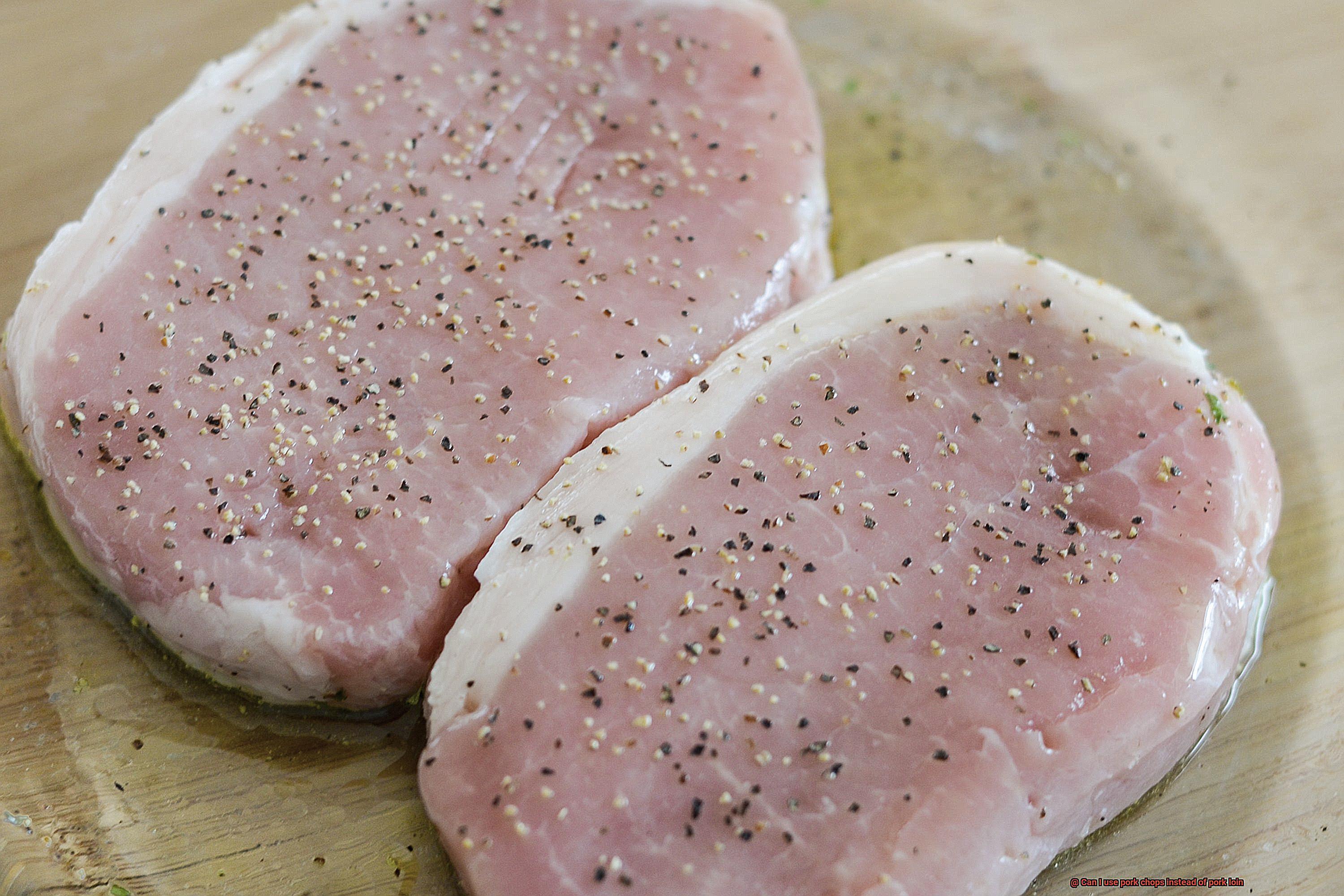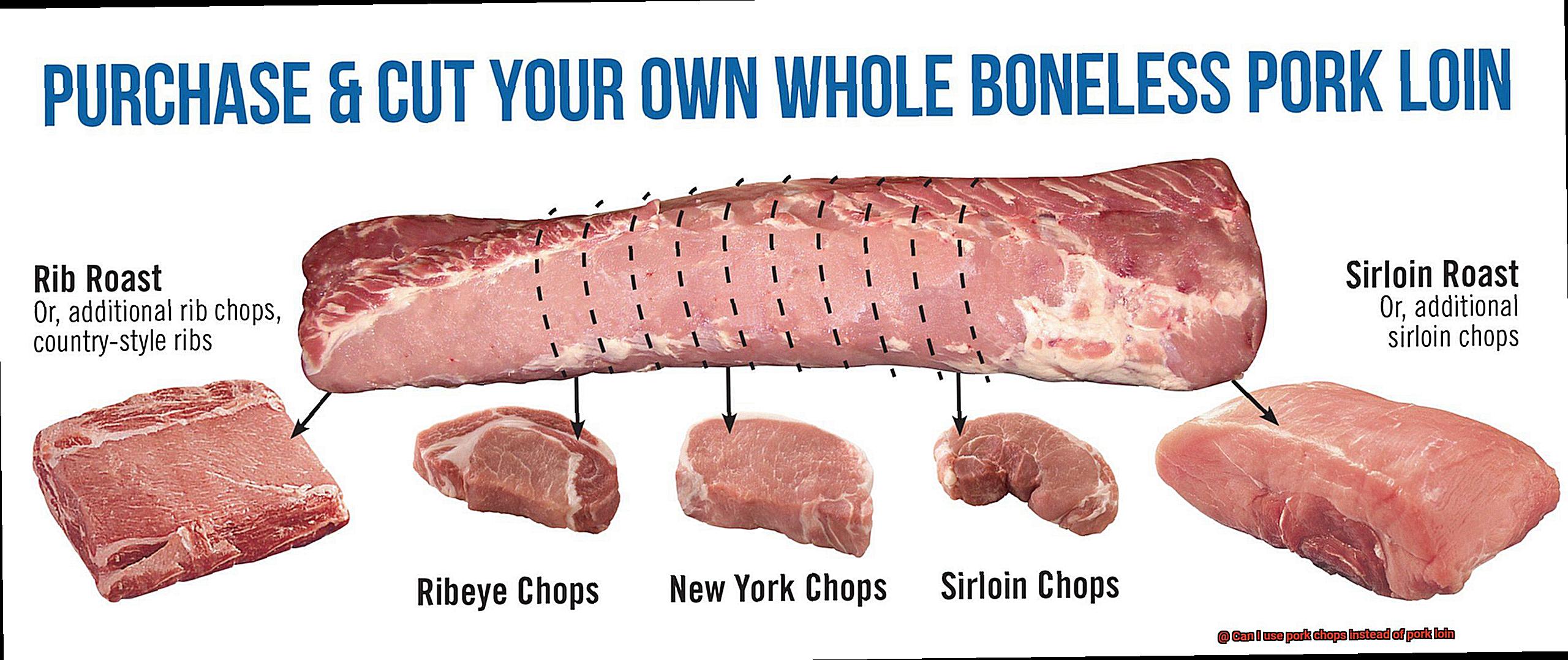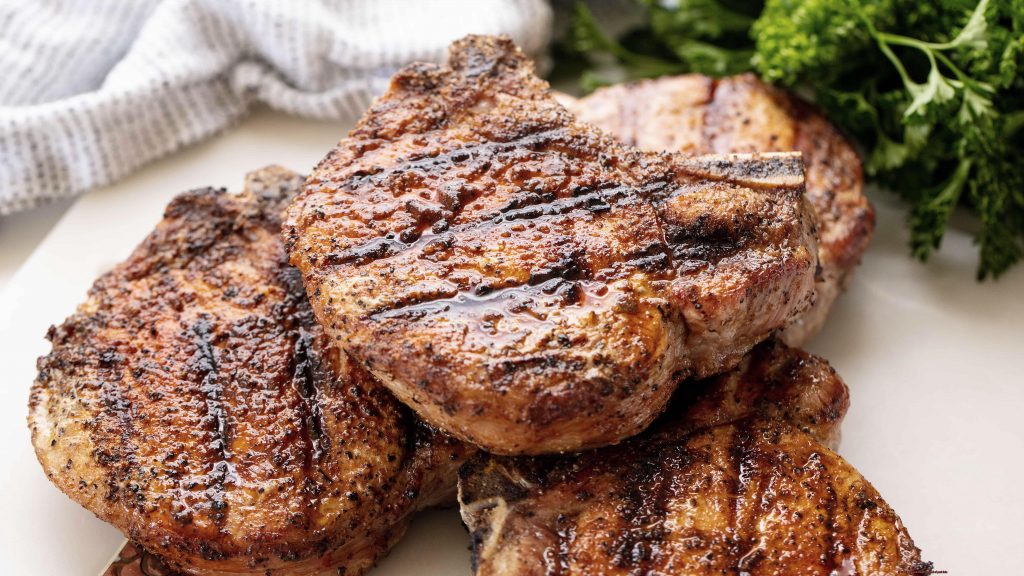Are you a foodie or just someone who loves to cook? If so, you may have found yourself pondering the difference between pork chops and pork loin. While both cuts come from the same animal, they have significant differences that can impact the flavor, texture, and cooking time of your dish.
The question on everyone’s mind is: can you use pork chops instead of pork loin? This debate has been raging among food enthusiasts for years. Some swear by using pork chops as a substitute for pork loin, while others insist that the two cuts are not interchangeable.
In this blog post, we’re going to explore the differences between these two popular cuts of meat and settle the debate once and for all – can you use pork chops instead of pork loin? We’ll delve into factors such as flavor, texture, cooking time, and more to help you make an informed decision when selecting the perfect cut of pork for your meal.
Whether you’re planning a quick weeknight dinner or a special occasion feast, understanding the nuances between pork chops and pork loin will give you confidence in your culinary skills. So let’s dive in together and discover whether or not it’s okay to swap out one cut for another.
Contents
What are Pork Chops?
Pork chops are a beloved cut of meat that has been savored by many for generations. What sets pork chops apart from other pork cuts, like pork loin? Let’s explore everything you need to know about pork chops.
First and foremost, pork chops come from the loin of a pig, which is a long and lean muscle that runs along the back of the animal from the shoulder to the hip. This part of the pig is exceptionally tender, making it perfect for grilling or pan-frying.
Pork chops come in different types, including center-cut, rib chop, and sirloin chop. Center-cut chops are the most popular and come from the center of the loin. Rib chops come from the rib section of the loin and have a small bone attached. Sirloin chops come from the rear end of the loin and are less tender than center-cut and rib chops.
Pork chops can be bone-in or boneless, and they are available in various thicknesses. Thicker cuts are ideal for grilling, while thinner ones are perfect for pan-frying. The thickness of your pork chop will impact cooking time and temperature, so it’s crucial to choose the appropriate thickness for your recipe.
Pork chops are incredibly versatile and can be prepared in many ways. Whether you’re grilling classic pork chops with a side of veggies or frying breaded pork chops with mashed potatoes, there’s no shortage of ways to enjoy this scrumptious cut of meat.

However, if you’re considering substituting pork chops for other cuts of pork like pork loin, there are some important factors to consider. Pork chops are usually thinner than pork loin, which can affect cooking time and temperature. Additionally, pork loin is typically more tender than pork chops, which can be tough if overcooked.
What is Pork Loin?
This lean and tender cut of meat is taken from the back of the pig, running from the shoulder to the hip. It is divided into different sections, including the sirloin end and the blade end, making it a versatile ingredient for any culinary creation.
Whether you prefer grilling, roasting or sautéing, pork loin can be prepared to perfection in a variety of ways. Looking for a challenge? Try stuffing it with your favorite ingredients or marinating it for an added kick of flavor. The possibilities are endless.
In addition to its delicious taste, pork loin is also a great source of nutrition. This cut of meat is packed with vitamins B6 and B12, iron and zinc – all essential for maintaining a healthy diet. However, it’s important to note that pork loin can be high in sodium, so keep an eye on your salt intake.

The Difference Between Pork Chops and Pork Loin
If you’re someone who loves to grill and is a fan of pork, then chances are, you’ve come across pork chops and pork loin at some point in your culinary adventures. Although both are delicious cuts of meat, they are not interchangeable when it comes to cooking. As an expert on the matter, let me break down the difference between these two popular cuts of meat.
Firstly, let’s talk about where these cuts come from. Pork chops are typically cut from the center of the loin and often include a bone. On the other hand, pork loin is a larger cut that runs along the spine of the pig and is usually sold boneless. This is a crucial distinction to keep in mind when deciding which cut to use in a recipe.
Another important factor to consider is thickness. Pork chops tend to be thinner than pork loin, making them easier to cook quickly on a grill or stovetop. Conversely, this also means that they can dry out more easily if overcooked. Pork loin, on the other hand, is thicker and can take longer to cook through. Therefore, it’s essential to keep this in mind when deciding which cut to use in your recipe.
Now let’s talk about fat content. Pork chops tend to have more fat than pork loin, which can add flavor and tenderness to the meat when cooked correctly. However, too much fat can also lead to flare-ups on the grill and an overly greasy end result. In contrast, pork loin is typically leaner than pork chops, making it a healthier choice for those watching their fat intake.
When it comes to grilling either cut of meat, there are a few things to keep in mind. Both pork chops and pork loin should be cooked over high heat for a short amount of time in order to get a nice sear on the outside while keeping the inside moist and tender. Additionally, don’t forget to let the meat rest for a few minutes after cooking to allow the juices to redistribute throughout the meat.
Thickness of Meat – Impact on Cooking Time and Temperature
Then, you know that achieving the perfect texture, flavor, and juiciness of these cuts requires careful consideration of their thickness. The thickness of meat plays a fundamental role in determining the cooking time and temperature needed to cook it to perfection.
Let’s start with pork chops. These are delicious cuts that are typically about 1 inch thick, much thinner than a full pork loin. As a result, they require less time to reach the desired internal temperature. However, cooking pork chops requires careful adjustment of cooking time and temperature to avoid overcooking or undercooking them.
To achieve perfectly cooked pork chops, you can either increase the oven temperature to 400°F and cook them for just 15-20 minutes while flipping them halfway through cooking or sear them on both sides in a hot skillet and then finish them off in the oven at 350°F for 10-15 minutes. Remember, thinner cuts of meat like pork chops are more prone to drying out if overcooked. Therefore, use a meat thermometer to ensure that the internal temperature reaches 145°F for medium-rare or 160°F for medium. Once the desired temperature is reached, remove the meat from heat immediately and let it rest for a few minutes before serving.
Now, let’s talk about pork loin. This cut is much thicker than pork chops, with some loins reaching up to 4 inches thick. As you can imagine, cooking pork loin requires a different approach as it takes longer for the heat to penetrate the meat.
If you were originally planning to roast a whole pork loin at 350°F for 1 hour and 30 minutes, you’ll need to adjust the cooking time depending on its thickness. For instance, a 2-pound pork loin requires 1 hour and 15 minutes of cooking at 350°F while a 3-pound pork loin requires 1 hour and 45 minutes of cooking at the same temperature. A 4-pound pork loin needs 2 hours and 15 minutes of cooking at 350°F. Of course, using a meat thermometer is crucial to ensure that the internal temperature reaches at least 145°F for medium-rare or 160°F for medium. Once it does, remove the pork loin from heat and let it rest for a few minutes before slicing.
Tenderness of Meat – Cost Considerations
Firstly, let’s talk about tenderness. While pork loin is generally more tender than pork chops, the latter can be just as mouth-watering if prepared correctly. However, cost is also a significant factor to consider when choosing between these two cuts of meat.
Pork chops can be a more affordable option than pork loin, but this doesn’t mean you should always go for the cheaper option. The quality and sourcing of the meat can impact the cost. Therefore it’s vital to consider all options before making a decision.
For instance, if you prioritize quality, a higher quality pork chop from a local farm or butcher might be more expensive than a lower quality pork loin from a grocery store. On the other hand, if you can find a deal on a larger cut of pork loin that you can portion and freeze for later use, it may end up being more cost-effective in the long run.
So, what else should you consider when deciding between pork chops and pork loin? Here are some additional factors to keep in mind:
- Cooking method: Both cuts can be cooked using various methods, but some methods may be better suited for one cut over the other. For example, pan-frying or grilling may work better for pork chops, while roasting or slow cooking may be better for pork loin.
- Flavor preferences: Do you prefer a leaner cut with a milder flavor (pork loin) or a fattier cut with a stronger flavor (pork chops)? Consider your personal taste preferences when making a decision.
- Availability: Depending on where you live, one cut may be more readily available than the other. If one cut is consistently out of stock or difficult to find, it may impact your decision.
Can You Substitute Pork Chops for Pork Loin?
As a discerning cook, it’s important to know that both cuts come from the same area of the pig but differ in size and thickness.
Pork loin is a large, lean cut of meat that weighs between 2 and 4 pounds, while pork chops are smaller cuts taken from the loin and range in thickness from ½ to 2 inches. Therefore, substituting pork chops for pork loin depends on what you’re cooking and how you plan to cook it.
If your recipe calls for a whole pork loin roast, substitute with caution. The cooking time and method may need adjusting to accommodate the smaller size and thickness of the chops. However, if you’re making sliced pork loin or pork medallions, swapping with pork chops is a viable option. Remember that thicker chops will take longer to cook than thinner ones.
Another crucial factor to consider when substituting pork chops for pork loin is the fat content. Pork loin is a lean cut of meat with very little marbling, while pork chops can have varying degrees of fat content depending on where they were cut from the loin. If you’re looking for a leaner option, boneless pork chops with little marbling are optimal.
Adjusting Cooking Methods When Using Pork Chops Instead of Pork Loin
Cooking pork chops instead of pork loin requires some adjustments to ensure that the meat is cooked to perfection. One of the main differences between these cuts of pork is their thickness. Pork chops are thinner than pork loin, which means they cook faster and can dry out more easily if not cooked properly. So, how can you adjust your cooking methods to make sure your pork chops are juicy and delicious?
First, use a meat thermometer to check the internal temperature of the pork. The ideal temperature for cooked pork is 145°F. This will ensure that the pork is safe to eat and still tender and juicy.
Secondly, marinating the pork chops before cooking can add flavor and moisture to the meat. A marinade made with olive oil, garlic, lemon juice, and herbs like rosemary or thyme can make your pork chops even more delicious and tender.
Finally, when it comes to cooking methods, grilling is a popular option for both pork chops and pork loin. When grilling pork chops, preheat the grill to medium-high heat and oil the grill grates before placing the meat on it. Cook the pork chops for about 4-5 minutes per side until they reach an internal temperature of 145°F.
cjVNcMyHnkU” >
Conclusion
In conclusion, the age-old question of whether pork chops can be used as a substitute for pork loin has been answered. While both cuts are derived from the same animal, they differ greatly in size, thickness, taste, texture and cooking time. Pork chops are smaller and thinner than pork loin and have a higher fat content. They are perfect for pan-frying or grilling and can be either bone-in or boneless. On the other hand, pork loin is a larger cut that runs along the pig’s spine and is usually sold boneless. It is leaner and more tender than pork chops.
When considering substituting pork chops for pork loin in your recipe, it’s important to take into account factors such as cooking method, meat thickness, tenderness of meat, preferred flavor profile, availability and cost. Adjustments may need to be made to account for the smaller size and thickness of chops.
To ensure that your pork chops turn out perfectly cooked every time, use a meat thermometer to check their internal temperature before serving them up on a plate. Marinating them beforehand will also help to enhance their flavor profile. Grilling is a popular option for both cuts of meat but requires careful attention to prevent drying out or overcooking.
Whether you’re planning a quick weeknight dinner or an elaborate feast, understanding the nuances between pork chops and pork loin will give you confidence in your culinary skills.






